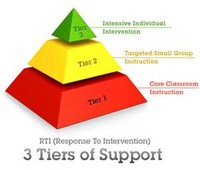RTI
-
Response to Intervention

The RTI model is a three-tiered system designed to meet the needs of all students. Curriculum based on the state standards and quality instruction are essential for student success. RTI is a multi-tiered approach that includes the following levels of intervention:

Tier I
In the general education setting, all students in Tier I receive high-quality, scientifically based instruction, differentiated to meet their needs, and are screened on a periodic basis to identify struggling learners who need additional support. Approximately 80% of the student population should respond successfully to Tier I interventions.
Tier II
In Tier II, students not making adequate progress in the core curriculum are provided with increasingly intensive instruction matched to their needs on the basis of levels of performance and rates of progress. About 15% of the students will need more intense instruction to be successful within the general education setting.
For students who are in Tier II, instruction is provided in smaller groups and may be more intense, frequent or specialized. Programs that have been shown to re-mediate skills successfully but that are not typically used for initial instruction in Tier I may be implemented. Continuous progress monitoring produces data and student progress/needs and decisions about instruction, movement between tiers and programmatic changes continue to be made by the Instructional Support Team (IST).
Tier III
At this level, approximately 5% of the student population will need individualized, intense interventions that target the student's skill deficits for the remediation of existing problems and the prevention of more severe problems.
For students who continue to struggle, the Instructional Support team may recommend moving the students to the last tier. These students have moved through the general education tiers, and data from continuous progress monitoring identified them as a group of students who are still not responding to instruction and who may, or may not, have specific learning disabilities. At this point, a comprehensive evaluation is designed and conducted to obtain additional data about cognition, achievement, behavior and/or social-emotional characteristics to see if a learning disability is present, identify individual student needs and plan appropriate remediation.
Each school building within the district has a Instructional Support Team (IST) or Response to Intervention Team (RTI). The purpose of the team is to discuss students who are struggling within the general education curriculum including the possible causes for their difficulty and a plan for implementation of interventions to support the student. If you have concerns about your child's academic skills, you may refer your child to their school's IST or RTI team by talking with your child's teacher or school counselor.

